- Strona główna
- O nas
- Branża
- Usługi
- Czytanie
- Kontakt
Rynek eCall w pojeździe: bieżąca analiza i prognoza (2024-2032)
Nacisk na według typu pojazdu (samochody osobowe, pojazdy użytkowe); według typu wyzwolenia (eCall inicjowane ręcznie, eCall inicjowane automatycznie), według typu napędu (silnik spalinowy, elektryczny) i regionów (Ameryka Północna (USA, Kanada, reszta Ameryki Północnej), Europa (Niemcy, Wielka Brytania, Francja, Włochy, Hiszpania, reszta Europy), Azja i Pacyfik (Chiny, Japonia, Indie, reszta Azji i Pacyfiku), reszta świata)
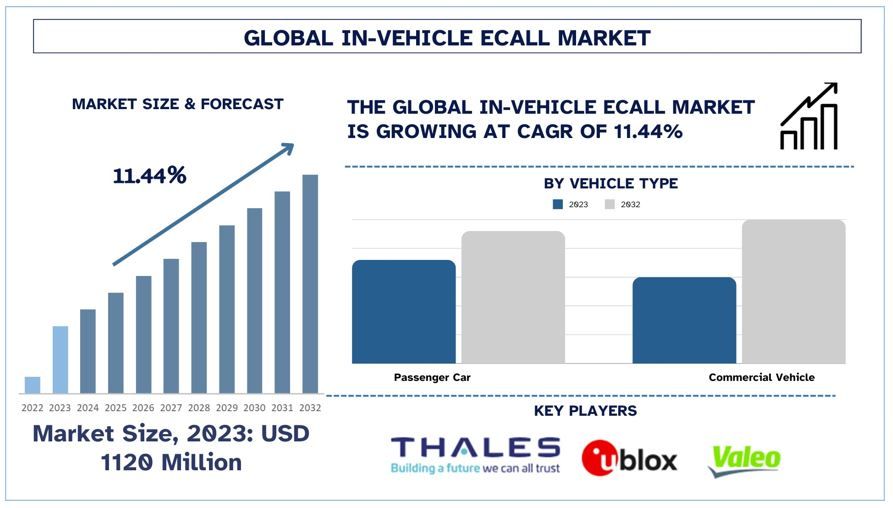
Rozmiar i prognoza globalnego rynku eCall w pojeździe
Wartość globalnego rynku eCall w pojeździe wyniosła 1120 milionów USD w 2023 roku i oczekuje się, że wzrośnie w silnym tempie CAGR na poziomie około 11,44% w okresie prognozy (2024-2032) ze względu na rosnące zapotrzebowanie na systemy bezpieczeństwa samochodów na całym świecie.
Analiza globalnego rynku eCall w pojeździe
Globalny rynek eCall w pojeździe odnotował znaczny wzrost w latach historycznych. eCall w pojeździe to usługa połączeń używana w przypadku wypadku do automatycznego lub ręcznego dzwonienia na podane numery w pojazdach w celu ograniczenia sytuacji zagrażających życiu pasażerów. eCall przesyła dane dotyczące czasu wypadku, kierunku wypadków i lokalizacji pojazdów do służb ratunkowych, aby skrócić czas dotarcia do osoby/osób w wypadku.
Wartość globalnego rynku eCall w pojeździe wyniosła 1120 milionów USD w 2023 roku i oczekuje się, że wzrośnie w silnym tempie CAGR na poziomie około 11,44% w okresie prognozy (2024-2032). Niektóre z kluczowych czynników, które doprowadziły do wyższego zapotrzebowania na systemy eCall, które mają być zintegrowane z nowoczesnymi samochodami osobowymi i pojazdami użytkowymi, to rosnący nacisk rządu i odpowiednich organów regulacyjnych na wdrażanie takich technologii ze względu na rosnącą liczbę wypadków drogowych. Ponieważ rozwijające się regiony, takie jak Europa, Ameryka Północna itp., już nałożyły obowiązek wdrożenia eCall w pojazdach samochodowych, rosnąca liczba wypadków drogowych w rozwijających się regionach również przyspieszy jego wdrożenie w tych regionach. Na przykład, według Światowej Organizacji Zdrowia, wypadki drogowe spowodowały około 1,35 miliona zgonów na całym świecie, z czego 93% miało miejsce w krajach o niskich i średnich dochodach. Według WHO, około 155 600 zgonów spowodowano tylko w Indiach w 2021 roku.
Biorąc pod uwagę wzrost zapotrzebowania na bezpieczeństwo w samochodach osobowych i komercyjnych, zapotrzebowanie na eCall w pojeździe również wzrośnie w nadchodzących latach.
Oprócz rosnącej sprzedaży samochodów w rozwijających się regionach, istnieje duże zapotrzebowanie na funkcje bezpieczeństwa w celu zmniejszenia liczby śmiertelnych wypadków na całym świecie z powodu wypadków drogowych. Biorąc pod uwagę zmiany, rynek eCall w pojeździe odnotuje szybki wzrost w latach 2024-2032.
Trendy na globalnym rynku eCall w pojeździe
Ta sekcja omawia kluczowe trendy rynkowe, które wpływają na różne segmenty globalnego rynku eCall w pojeździe, zidentyfikowane przez nasz zespół ekspertów ds. badań.
Integracja z ADAS
W ostatnich latach integracja zaawansowanych systemów wspomagania kierowcy stała się jedną z kluczowych cech w motoryzacji. Zaawansowane systemy wspomagania kierowcy działają w połączeniu z dużą liczbą czujników, takich jak radar, czujniki ultradźwiękowe, kamery, czujniki ciśnienia, systemy eCall itp., aby nie tylko płynnie prowadzić, ale także wdrażać systemy bezpieczeństwa w razie potrzeby.
Wraz ze wzrostem dochodu do dyspozycji klienci poszukują lepszych funkcji i elementów bezpieczeństwa w swoich pojazdach, co skłoniło firmy do przyjęcia podobnego podejścia poprzez integrację funkcji bezpieczeństwa w istniejących modelach pojazdów.
Ponieważ systemy ADAS wdrażają wszystkie funkcje bezpieczeństwa podczas i po wypadku, konieczne jest automatyczne informowanie władz o wypadku w celu zaoszczędzenia czasu i dalszych uszkodzeń pasażerów po wypadku oraz uzyskania pomocy medycznej. Biorąc to pod uwagę, oczekuje się, że integracja eCall z systemami ADAS wzrośnie w nadchodzących latach.
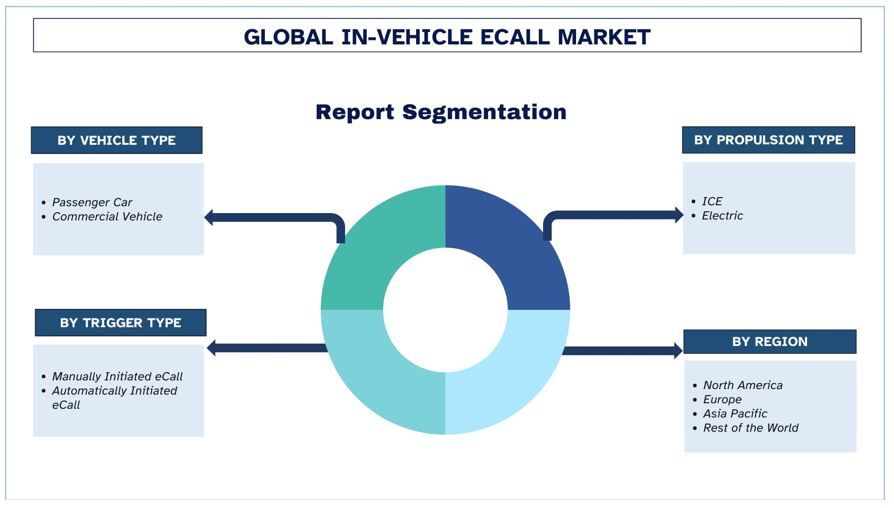
Oczekuje się, że Europa utrzyma główny udział w rynku w okresie prognozy
Europa utrzymuje znaczny udział w globalnym rynku eCall w pojeździe. Dzięki mandatom rządowym dotyczącym wdrożenia technologii eCall we wszystkich pojazdach, region ten wykazał wyższy wskaźnik wzrostu na rynku eCall. Jednym z kluczowych czynników, które doprowadziły do wyższego zapotrzebowania na systemy eCall, które mają być zintegrowane z nowoczesnymi samochodami osobowymi i pojazdami użytkowymi, jest rosnący nacisk rządu i odpowiednich organów regulacyjnych na wdrażanie takich technologii. Na przykład w 2018 roku Unia Europejska ogłosiła uruchomienie mandatu eCall dla lekkich eCall, lekkich ciężarówek. Ponadto w 2024 r. Unia Europejska nałożyła dalszy obowiązek modernizacji eCall do 5G. Ta usługa eCall zapewnia zarówno ręczne, jak i automatyczne bezpłatne odpowiedzi dla władz w celu skrócenia czasu reakcji.
Biorąc pod uwagę aktualizacje, oczekuje się, że region wykaże podobny trend w prognozowanych latach, tj. 2024-2032.
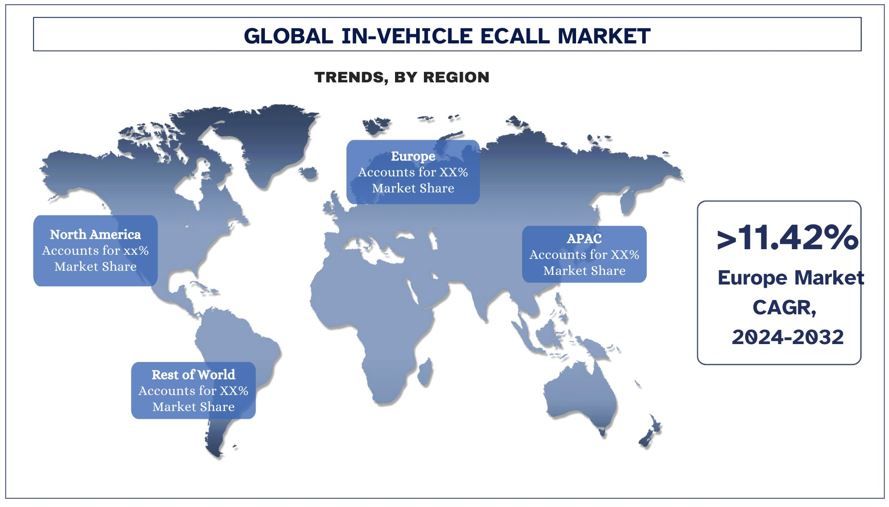
Przegląd globalnego przemysłu eCall w pojeździe
Globalny rynek eCall w pojeździe jest konkurencyjny i rozdrobniony, z obecnością kilku globalnych i międzynarodowych graczy rynkowych. Kluczowi gracze przyjmują różne strategie wzrostu w celu zwiększenia swojej obecności na rynku, takie jak partnerstwa, umowy, współpraca, wprowadzanie nowych produktów, ekspansja geograficzna oraz fuzje i przejęcia. Niektórzy z głównych graczy działających na rynku Continental AG, Robert Bosch GmbH, Thales Group, STMicroelectronics, U-blox, Texas Instrument Incorporated, Valeo, Infineon Technologies AG, 1NCE Pvt. Ltd. i Anritsu.
Wiadomości z globalnego rynku eCall w pojeździe
- W 2020 r., według Automotive Research Association of India (ARAI), oczekuje się, że usługi eCall zostaną wdrożone w Indiach w nadchodzących latach po pomyślnej integracji w Unii Europejskiej.
Zakres raportu globalnego rynku eCall w pojeździe
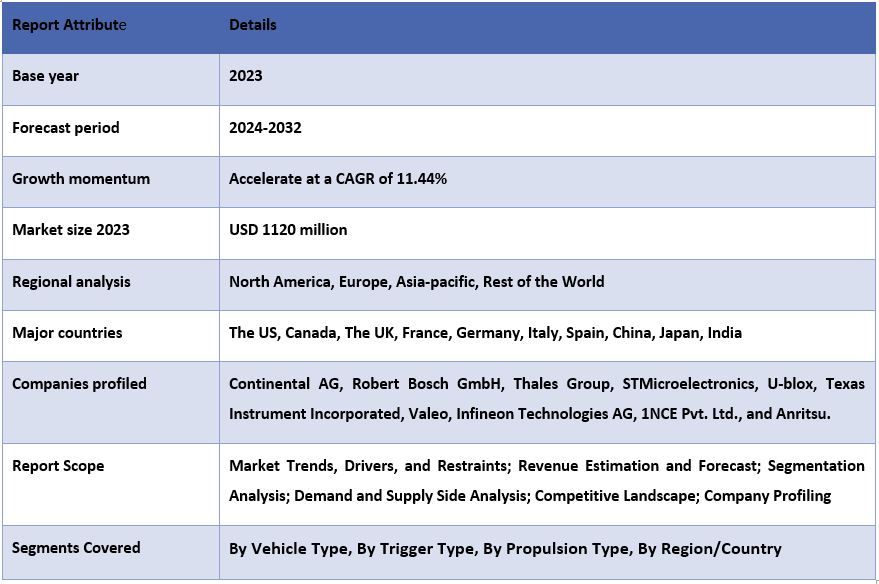
Powody, dla których warto kupić ten raport:
- Badanie obejmuje analizę wielkości i prognoz rynkowych zweryfikowaną przez uwierzytelnionych kluczowych ekspertów branżowych.
- Raport przedstawia szybki przegląd ogólnej wydajności branży na pierwszy rzut oka.
- Raport obejmuje dogłębną analizę wybitnych podmiotów w branży ze szczególnym uwzględnieniem kluczowych danych finansowych przedsiębiorstw, portfeli produktów, strategii ekspansji i ostatnich zmian.
- Szczegółowe badanie czynników napędzających, ograniczeń, kluczowych trendów i możliwości panujących w branży.
- Badanie kompleksowo obejmuje rynek w różnych segmentach.
- Dogłębna analiza branży na poziomie regionalnym.
Opcje dostosowywania:
Globalny rynek eCall w pojeździe można dodatkowo dostosować do wymagań lub dowolnego innego segmentu rynku. Poza tym UMI rozumie, że możesz mieć własne potrzeby biznesowe; dlatego skontaktuj się z nami, aby uzyskać raport, który całkowicie odpowiada Twoim wymaganiom.
Spis treści
Metodologia badań dla analizy globalnego rynku eCall w pojeździe (2024-2032)
Analiza historycznego rynku, oszacowanie obecnego rynku i prognozowanie przyszłego rynku globalnego rynku eCall w pojeździe były trzema głównymi krokami podjętymi w celu stworzenia i analizy wdrożenia globalnego eCall w pojeździe w głównych regionach na całym świecie. Przeprowadzono wyczerpujące badania wtórne w celu zebrania historycznych danych rynkowych i oszacowania bieżącej wielkości rynku. Po drugie, aby zweryfikować te spostrzeżenia, wzięto pod uwagę liczne ustalenia i założenia. Ponadto przeprowadzono również wyczerpujące wywiady pierwotne z ekspertami branżowymi w całym łańcuchu wartości globalnego rynku eCall w pojeździe. Po założeniu i walidacji danych rynkowych za pośrednictwem wywiadów pierwotnych, zastosowaliśmy podejście odgórne/oddolne do prognozowania pełnej wielkości rynku. Następnie zastosowano metody podziału rynku i triangulacji danych w celu oszacowania i analizy wielkości rynku segmentów i podsegmentów branży. Szczegółowa metodologia wyjaśniona poniżej:
Analiza historycznej wielkości rynku
Krok 1: Dogłębne badanie źródeł wtórnych:
Przeprowadzono szczegółowe badania wtórne w celu uzyskania historycznej wielkości globalnego rynku eCall w pojeździe za pośrednictwem wewnętrznych źródeł firm, takich jak raporty roczne i sprawozdania finansowe, prezentacje wyników, komunikaty prasowe itp., oraz źródeł zewnętrznych, w tym czasopism, wiadomości i artykułów, publikacji rządowych, publikacji konkurencji, raportów sektorowych, baz danych stron trzecich i innych wiarygodnych publikacji.
Krok 2: Segmentacja rynku:
Po uzyskaniu historycznej wielkości globalnego rynku eCall w pojeździe przeprowadziliśmy szczegółową analizę wtórną w celu zebrania historycznych informacji rynkowych i udziałów dla różnych segmentów i podsegmentów dla głównych regionów. Główne segmenty zawarte są w raporcie jako według typu pojazdu i według typu wyzwalacza, według typu napędu. Ponadto przeprowadzono analizy na poziomie regionalnym/krajowym w celu oceny ogólnego przyjęcia modeli testowych w danym regionie.
Krok 3: Analiza czynnikowa:
Po uzyskaniu historycznej wielkości rynku różnych segmentów i podsegmentów przeprowadziliśmy szczegółową analizę czynnikową w celu oszacowania bieżącej wielkości globalnego rynku eCall w pojeździe. Ponadto przeprowadziliśmy analizę czynnikową z wykorzystaniem zmiennych zależnych i niezależnych, takich jak według typu pojazdu i według typu wyzwalacza, według typu napędu na globalnym rynku eCall w pojeździe. Przeprowadzono dokładną analizę scenariuszy popytu i podaży, biorąc pod uwagę najważniejsze partnerstwa, fuzje i przejęcia, ekspansję biznesu oraz wprowadzenia produktów w sektorze globalnego rynku eCall w pojeździe na całym świecie.
Szacowanie i prognoza bieżącej wielkości rynku
Określanie wielkości rynku bieżącego:Na podstawie przydatnych spostrzeżeń z powyższych 3 kroków doszliśmy do bieżącej wielkości rynku, kluczowych graczy na globalnym rynku eCall w pojeździe oraz udziałów rynkowych segmentów. Wszystkie wymagane udziały procentowe i podziały rynku zostały określone przy użyciu wyżej wymienionego podejścia wtórnego i zweryfikowane za pośrednictwem wywiadów pierwotnych.
Szacowanie i prognozowanie:Do estymacji i prognoz rynkowych przypisano wagi różnym czynnikom, w tym czynnikom napędowym i trendom, ograniczeniom i możliwościom dostępnym dla interesariuszy. Po przeanalizowaniu tych czynników zastosowano odpowiednie techniki prognozowania, tj. podejście top-down/bottom-up, w celu uzyskania prognozy rynkowej na rok 2032 dla różnych segmentów i podsegmentów na głównych rynkach globalnie. Metodologia badawcza przyjęta do oszacowania wielkości rynku obejmuje:
- Wielkość rynku branży, pod względem przychodów (USD) oraz wskaźnik adopcji globalnego rynku In-Vehicle eCall na głównych rynkach krajowych
- Wszystkie udziały procentowe, podziały i podziały segmentów i podsegmentów rynku
- Kluczowi gracze na globalnym rynku In-Vehicle eCall pod względem oferowanych produktów. Ponadto strategie wzrostu przyjęte przez tych graczy w celu konkurowania na szybko rozwijającym się rynku.
Walidacja Wielkości i Udziału Rynku
Badania Pierwotne:Przeprowadzono dogłębne wywiady z kluczowymi liderami opinii (KOL), w tym z dyrektorami najwyższego szczebla (CXO/Wiceprezesami, Szefami Sprzedaży, Szefami Marketingu, Szefami Operacyjnymi, Szefami Regionalnymi, Szefami Krajowymi itp.) w głównych regionach. Odkrycia pierwotne zostały następnie podsumowane i przeprowadzono analizę statystyczną w celu udowodnienia postawionej hipotezy. Dane z badań pierwotnych zostały skonsolidowane z ustaleniami wtórnymi, przekształcając tym samym informacje w możliwe do zastosowania wnioski.
Podział Uczestników Pierwotnych w Różnych Regionach
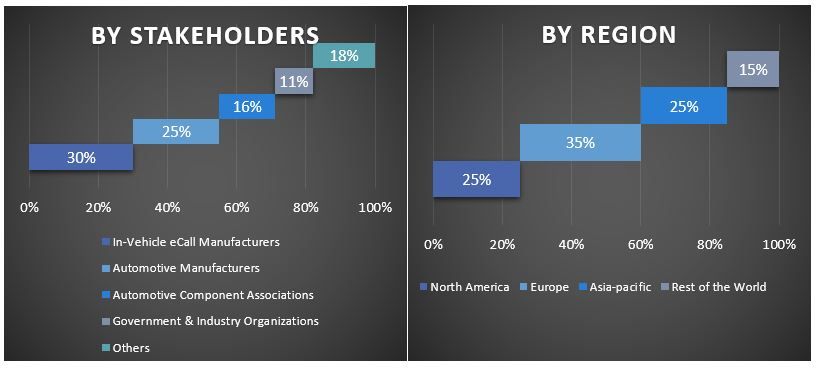
Inżynieria Rynku
Zastosowano technikę triangulacji danych w celu zakończenia ogólnej estymacji rynku i uzyskania precyzyjnych liczb statystycznych dla każdego segmentu i podsegmentu globalnego rynku In-Vehicle eCall. Dane podzielono na kilka segmentów i podsegmentów po przestudiowaniu różnych parametrów i trendów według typu pojazdu, według typu wyzwalacza, według typu napędu na globalnym rynku In-Vehicle eCall.
Główny cel badania globalnego rynku In-Vehicle eCall
W badaniu wskazano obecne i przyszłe trendy rynkowe globalnego rynku In-Vehicle eCall. Inwestorzy mogą uzyskać strategiczne wglądy, aby oprzeć swoją decyzję o inwestycjach na analizie jakościowej i ilościowej przeprowadzonej w badaniu. Obecne i przyszłe trendy rynkowe określają ogólną atrakcyjność rynku na poziomie regionalnym, zapewniając platformę dla uczestników branżowych, aby wykorzystać niewykorzystany rynek i skorzystać z przewagi pierwszego gracza. Inne cele ilościowe badań obejmują:
- Analiza obecnej i prognozowanej wielkości rynku globalnego rynku In-Vehicle eCall pod względem wartości (USD). Ponadto analiza obecnej i prognozowanej wielkości rynku różnych segmentów i podsegmentów.
- Segmenty w badaniu obejmują obszary według typu pojazdu i według typu wyzwalacza, według typu napędu.
- Zdefiniowanie i analiza ram regulacyjnych dla globalnej branży In-Vehicle eCall.
- Analiza łańcucha wartości związanego z obecnością różnych pośredników, wraz z analizą zachowań klientów i konkurencji w branży.
- Analiza obecnej i prognozowanej wielkości rynku globalnego rynku In-Vehicle eCall dla głównych regionów.
- Główne kraje regionów objętych badaniem w raporcie obejmują Amerykę Północną (USA, Kanada i reszta Ameryki Północnej), Europę (Wielka Brytania, Francja, Niemcy, Włochy, Hiszpania, reszta Europy), Azję i Pacyfik (Chiny, Japonia, Indie, reszta Azji i Pacyfiku), Reszta świata
- Profile firm na globalnym rynku In-Vehicle eCall oraz strategie wzrostu przyjęte przez graczy rynkowych w celu utrzymania się na szybko rozwijającym się rynku.
- Dogłębna analiza branży na poziomie regionalnym
Najczęściej zadawane pytania FAQ
P1: Jaki jest aktualny rozmiar rynku i potencjał wzrostu globalnego rynku eCall w pojeździe?
P2: Jaki jest czynnik napędzający wzrost globalnego rynku eCall w pojeździe?
P3: Który segment ma największy udział w globalnym rynku eCall w pojeździe według typu pojazdu?
P4: Który region zdominuje globalny rynek eCall w pojeździe?
Powiązane Raporty
Klienci, którzy kupili ten przedmiot, kupili również










